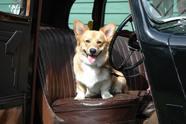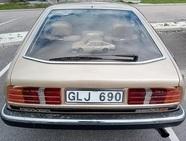Rust in P6 Rovers
The following points where rust has caused problems have been noted in recent car stripping operations. Most are normally hidden from sight and require the removal of external panels to gain access for checking or fixing. With the P6 this is a relatively simple process as every panel is removable and replaceable without difficulty and without causing external paint damage if sensible care is taken.
1. Open each door and carefully check behind the door seal rubbers mounted in the body frame. Remove the stainless steel scuff plates and check under them as well.
2. Check the lower corners of front and rear windscreens. This will require the removal of the painted metal trim panels to really see what is happening. If the screen rubber is folded or crimped, water will be trapped leading to rust in the channel in the A or C pillar and can lead to rust right across the dash top if the sponge rubber air seal remains damp.
3. High up under the rear guards is a rubber seal designed to catch and retain mud/slush and gravel flung up by the wheels. I suspect that the intention is to create a block to such access to dirt and salt etc but nearly all the cars I have seen have this rubber installed with the lip curving up which creates a lovely little dam for the retention of wet dirt and other rubbish forced past the rubber by the intensity of the water and dirt velocity coming off the rear wheels. This can only be accessed after removal of the rear mudguards which is luckily a very simple job. One of my cars had holes rusted right through into the boot above the rear wheel arch so check it soon! While the rear guards are off clean all round the tail light assembly also as this is a favourite mud/slush resting spot.
4. Rear boot frame between the bumper bar and boot and around the (rear axle) top link pivots. Check this while the rear guards are off and remove the rear valance (below the boot lid) to do a thorough job. Many owners have found holes in the rear corners of their boots caused by mud/slush building up below the tail-lights and there have been instances reported of the back wheel coming loose at speed after the top link pivot has pulled out of the rusty boot side (which causes an interesting rear wheel stearing effect I believe). The extra panel at the rear of the boot inside the trim panel can become filled with mud/slush and water and rust out and as the jacking block is integral with this panel and rear of the boot this could be very expensive to repair if not corrected early.
5. Main chassis box or frame along both sides of the car. Check by removing back seats to check inside and if necessary remove front seats and carpet. To check from outside you need to remove the rocker panel which, while simple in theory, is often tedious in practice due to rust-seized screws. The inside of this box is primed with some special rust preventive paint during manufacture and there are several drain holes along its bottom edge but these can become blocked with mud/slush and then the rust starts eating away your structural strength. Well worth injecting fisholene through the holes on the inside of the frame. Check also that the little cover bungs placed into the ends of this box section in the rear wheel arch (viewable from the wheel arch and often obscured by tar paint) are still in place and effective, otherwise they should be replaced or at least re-sealed.
6. Doors. Notorious in all makes for rusting out along the lower joint. In some New Zealand fabricated cars I have observed NO PAINT WHATSOEVER inside the doors. (Note for UK & US Roverphiles: Australian cars were imported either as complete cars from England or, more often, after being fabricated in New Zealand from CKD kits exported by the factory for the purpose.)
7. Under the floor carpets. Seams around wheel arch and along floor edges were sealed in manufacture with a healthy bead of sealing goo. I have observed situations where the seal is missing, whether pulled out during repair or never put in I cannot say, and such seams leak and the heavy underfelt gets wet resulting in rusting floors. Windscreen rubbers (both front and rear) are another notorious source of leaks which trickle down behind the upholstery and dash to end up under the carpets, or in the back under the seats in that well beside the main body side beam.
8. Inside the front guards both at the front around the parking lights and at the rear where a corrugated beam stands only a few mm from the outer skin to support the lower rear of the wheel arch. Mud/slush build-up in either place leads to rapid rusting from the inside which can be prevented through regular in-situ cleaning. At the rear of the front guard is a panel attached to which is a rubber seal and dirt forces its way past this seal to accumulate along the back of the seal and cause a rusty nuisance also.
9. All P6 Rovers were undersealed with a heavy tar based goo during manufacture. This has proved remarkably good at keeping water and gravel away from the painted underneath of the floor pan. However, after thirty or more years this goo should be carefully inspected every few months to ensure it is still doing the job it was designed to do and hasn't become a trap behind which water is held. The tar can become cracked but still hang in place thus providing not only access to the steel floor but a dam holding a thin film of moisture up against the steel floor which leads to rapid rusting. Tap the tarry film with your finger to ensure it is still firmly adhering everywhere and look closely for any sign of cracks or missing bits.
If you have never done so, the idea of removing panels from your P6 may seem rather daunting. However it is relatively easy to do and may well prevent a serious rust problem. It would be very simple to remove the front & rear bumper bars, the four mudguards, all the seat squabs and floor carpets, thoroughly check all the above points, apply fisholene or other rust protection and replace everything in one afternoon, but novices should allow a day and check your service manual or obtain some experienced advice before you start.
Regards
Ian Harrison



